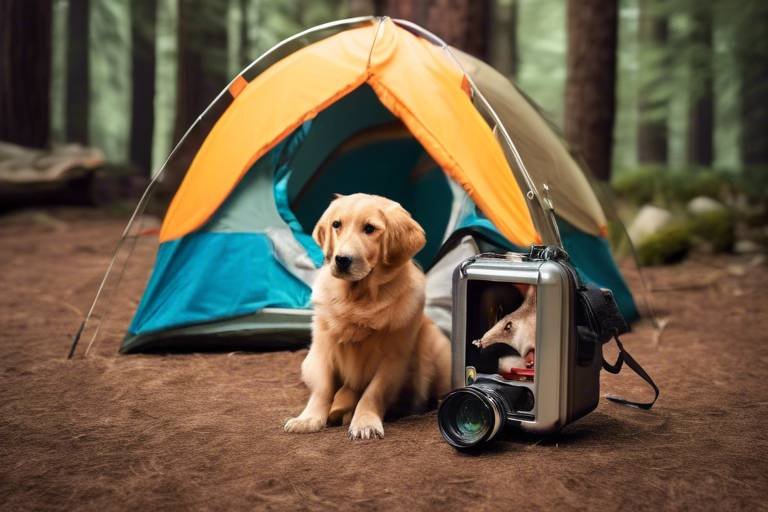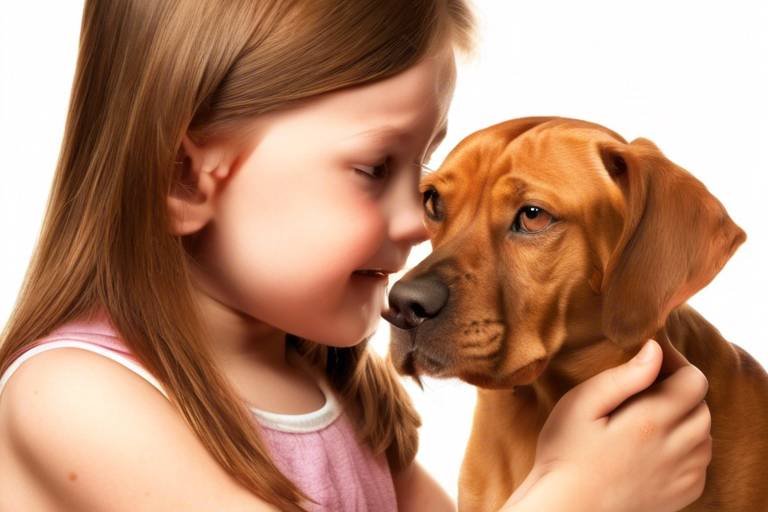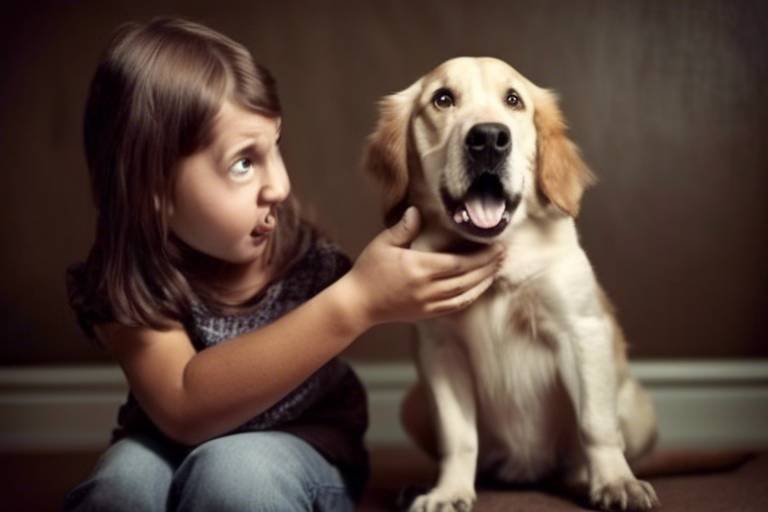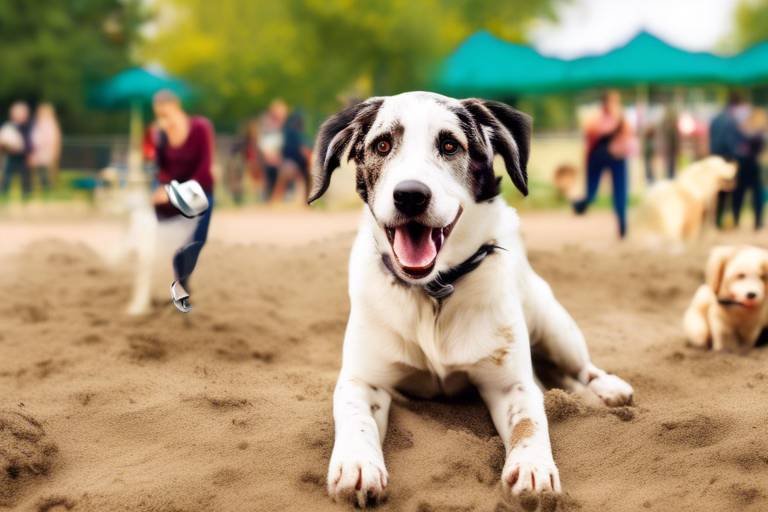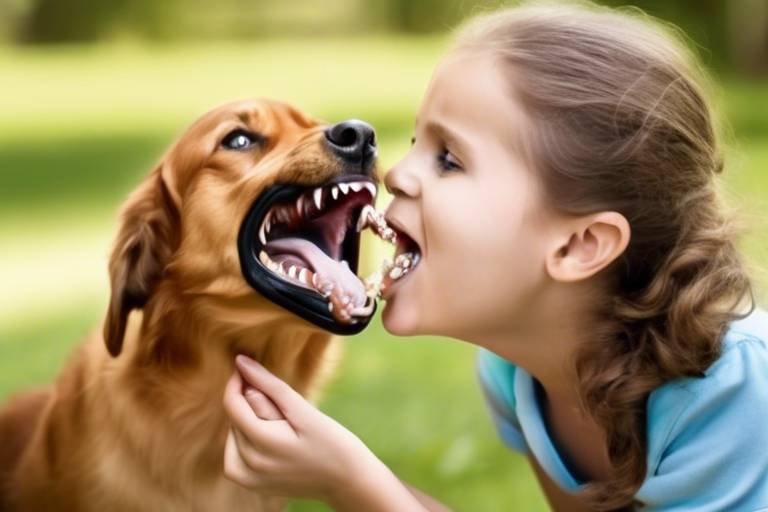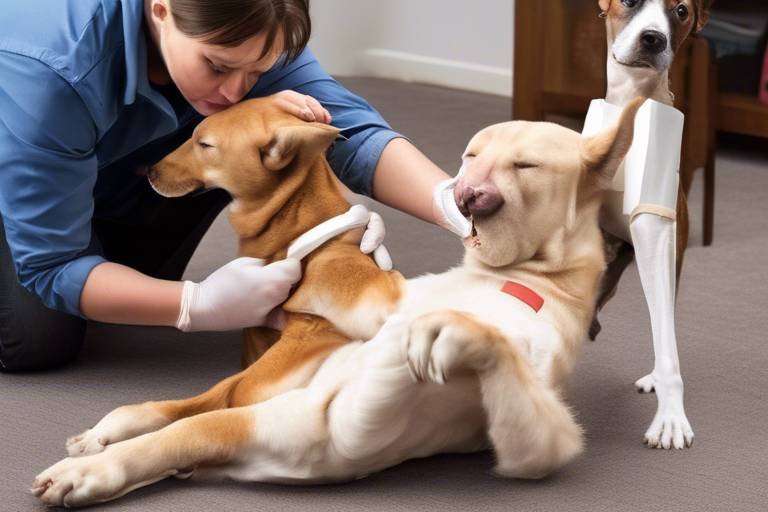How to Protect Your Pet from Extreme Temperatures
This article discusses essential strategies to keep your pets safe during extreme weather conditions, including heatwaves and freezing temperatures, ensuring their comfort and well-being throughout the year. As loving pet owners, it's our responsibility to shield our furry friends from the harsh elements of nature. Just like we bundle up in winter coats or seek shade during a hot summer day, our pets need similar protection. Understanding their needs in extreme temperatures can make all the difference in their health and happiness.
Recognizing the signs of extreme temperatures is crucial for pet owners. Pets, like humans, can suffer from the effects of both heat and cold. When the mercury rises, our pets can quickly become overheated, leading to serious health issues. Conversely, frigid temperatures can lead to hypothermia and frostbite. It's vital to monitor weather conditions regularly, especially during seasons known for temperature extremes. Keeping an eye on the forecast helps you prepare for potential weather-related challenges and ensures you can take proactive measures to protect your pet.
Identifying heat stress symptoms in pets is vital for timely intervention. When the temperature soars, our furry companions can struggle to cope. Here are some common signs to watch for:
- Excessive panting: If your pet is panting heavily, it may be a sign they are overheating.
- Drooling: Increased drooling can indicate that your pet is feeling the heat.
- Lethargy: A sudden lack of energy or unwillingness to move can signal heat stress.
Being vigilant about these signs allows you to act quickly and prevent serious health issues. The sooner you recognize the symptoms, the faster you can implement cooling measures to help your pet recover.
Pets may exhibit unusual behaviors during heat stress. You might notice your usually playful pup lying around or your curious kitty refusing to explore. These behavioral changes are often the first indicators that something is wrong. If your pet seems disinterested in their favorite activities, it’s time to check on their well-being. Just like humans, pets can become irritable and restless when uncomfortable, so keep an eye on their mood and energy levels.
Physical signs like drooling and rapid heartbeat can signal heat stress. If you notice your pet's heart racing or they are excessively salivating, it’s crucial to take immediate action. Cooling them down should be your top priority. You can use a damp cloth to help lower their body temperature or provide them with cool, fresh water. Remember, every moment counts when it comes to heat stress!
Preventing heat stress is key to pet safety. Here are some effective strategies to keep your pet cool and comfortable:
- Provide shade: Ensure your pet has access to shaded areas when outdoors.
- Hydration: Always have fresh water available to keep your pet hydrated.
- Avoid peak hours: Try to limit outdoor activities during the hottest parts of the day, typically between 10 AM and 4 PM.
By taking these simple yet effective measures, you can significantly reduce the risk of heat stress and keep your pet happy and healthy during those scorching summer days.
Cold weather poses its own risks to pets. Just like us, animals can feel the chill, and it's essential to recognize cold-related issues. Pets that spend too much time outdoors in freezing temperatures can suffer from frostbite or hypothermia. Knowing when it's too cold for your pet to be outside is crucial. If it's too cold for you, it's likely too cold for them!
Hypothermia can be life-threatening for pets. Symptoms like shivering, weakness, and lethargy are clear indicators that your pet may be too cold. If you notice these signs, it’s crucial to bring them inside immediately and warm them up. Hypothermia can escalate quickly, so don't delay in taking action.
Investing in proper winter gear can protect pets from the cold. Just like we wear coats and gloves, our pets can benefit from winter clothing. Here are some essential items to consider:
- Dog coats: Insulated jackets can help keep your dog warm during walks.
- Booties: Protect their paws from ice and salt with dog booties.
- Pet sweaters: A cozy sweater can provide extra warmth for smaller breeds.
By equipping your pets with the right gear, you can ensure they stay warm and comfortable during those chilly winter outings.
A safe environment is crucial for pet protection. Preparing your home and yard for extreme temperatures can enhance your pet's safety and comfort. Make sure your indoor space is cozy and warm during winter, and keep it cool and breezy during summer. Providing a comfortable resting area is essential for your pet's well-being.
Keeping pets safe indoors during extreme weather is essential. Ensure that your home is well-ventilated in the summer and adequately heated in the winter. You can use fans or air conditioning to keep your pet cool during hot days, while blankets and heaters can help them stay warm when temperatures drop. Regularly check that your pet has a comfortable spot to rest, away from drafts or direct heat sources.
When pets must be outdoors, safety precautions are necessary. Make sure they have access to shelter and warmth, especially during cold spells. If your pet spends time outside, consider building a safe, insulated shelter where they can escape the elements. Additionally, always supervise outdoor playtime to ensure they don’t overheat or get too cold.
Q: How can I tell if my pet is too hot or too cold?
A: Look for signs like excessive panting or drooling in heat, and shivering or lethargy in cold. Always monitor their behavior closely.
Q: What should I do if my pet shows signs of heat stress?
A: Move them to a cooler area, offer water, and use wet cloths to cool them down. If symptoms persist, contact your veterinarian.
Q: Is it safe to walk my pet during extreme temperatures?
A: It’s best to avoid walks during peak heat hours in summer and limit outdoor time in freezing temperatures during winter.
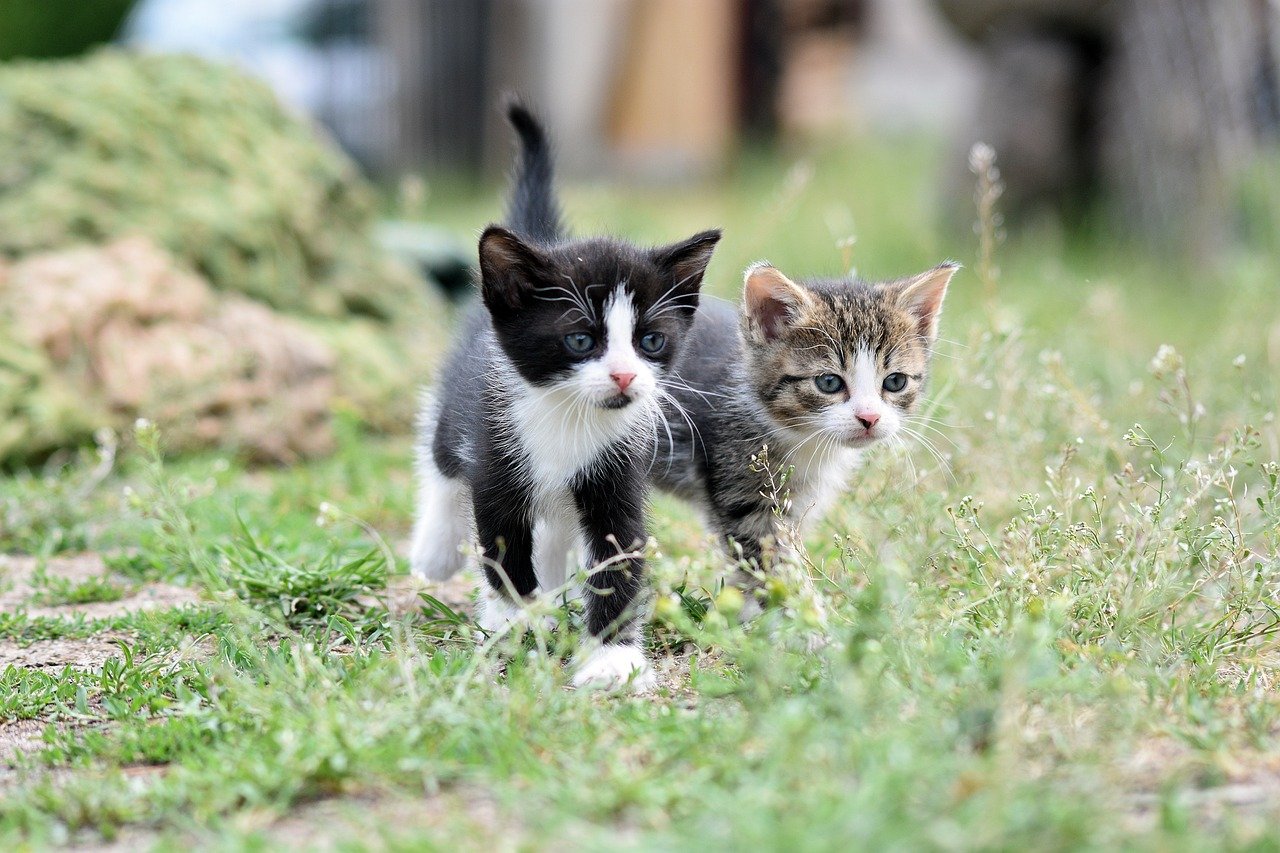
Understanding Temperature Extremes
As pet owners, we often think about our furry friends' happiness and health, but how often do we consider the impact of extreme temperatures on their well-being? Just like us, pets can suffer from the effects of both heat and cold, and being aware of these conditions is crucial for their safety. When the thermometer swings to either end of the spectrum, it’s essential to understand how these fluctuations can affect our pets.
During the scorching summer months, high temperatures can lead to serious health risks for pets. Dogs and cats are particularly vulnerable because they lack the ability to sweat like humans do. Instead, they rely on panting and other mechanisms to cool down. When temperatures soar above 85°F (29°C), pets can quickly become overheated, leading to heat stress or even heat stroke. It's vital to monitor the weather and recognize when it's too hot for your pet to be outdoors.
On the flip side, winter brings its own set of challenges. Just as we bundle up in layers, our pets need protection from the biting cold. Animals can experience hypothermia and frostbite, especially those with short coats or small body sizes. For instance, temperatures below 32°F (0°C) can be dangerous for pets that are not acclimated to the cold. Understanding the signs of discomfort and distress in pets during these frigid months can save their lives.
To help you navigate these temperature extremes, here’s a quick reference table that outlines the temperature ranges and the associated risks for pets:
| Temperature Range | Risk Level | Recommended Action |
|---|---|---|
| Above 85°F (29°C) | High Risk of Heat Stress | Keep pets indoors, provide water, and limit exercise |
| 70°F - 85°F (21°C - 29°C) | Moderate Risk | Monitor pets closely, ensure hydration |
| 32°F - 70°F (0°C - 21°C) | Low Risk | Normal activities, but watch for signs of discomfort |
| Below 32°F (0°C) | High Risk of Hypothermia | Limit outdoor time, provide warm shelter |
Ultimately, being vigilant and proactive about weather conditions can make a world of difference in your pet's health and comfort. By staying informed and prepared, you can ensure that your beloved companions thrive, regardless of the temperature outside. Remember, a little extra care goes a long way in protecting your furry friends from the elements!

Signs of Heat Stress in Pets
As pet owners, it's our responsibility to ensure the well-being of our furry companions, especially during those sweltering summer days. Heat stress can sneak up on pets faster than you might think, and recognizing the signs is crucial for their safety. Just like humans, pets can suffer from the heat, and sometimes they can’t communicate their discomfort in a way we understand. So, what should you be on the lookout for? Let’s dive into some common indicators of heat stress in pets.
One of the first signs that your pet might be overheating is excessive panting. While it’s normal for dogs to pant, especially after exercise, if you notice your pet panting heavily even when they’re resting, it’s a red flag. Think of it like your pet's way of waving a little white flag, saying, "Help! It’s too hot for me!" Alongside panting, you might see your pet exhibiting lethargy. If your usually playful pup suddenly prefers to lay around instead of chasing after their favorite toy, it might be time to cool them down.
Another concerning symptom is drooling. While a little drool is typical for many pets, an increase in drool can indicate that your furry friend is struggling to cope with the heat. Additionally, keep an eye out for signs like rapid heartbeat and weakness. These physical symptoms can escalate quickly and may lead to serious health issues if not addressed promptly. If you notice any of these signs, it's crucial to take immediate action to cool your pet down.
To help you better understand these signs, here’s a quick reference table:
| Signs of Heat Stress | Description |
|---|---|
| Excessive Panting | Heavy breathing even when resting, indicating discomfort. |
| Lethargy | Unusual tiredness or lack of energy, preferring to lie down. |
| Drooling | Increased saliva production, which can signal overheating. |
| Rapid Heartbeat | Elevated heart rate, which can be dangerous if not addressed. |
| Weakness | General weakness or inability to stand or walk properly. |
In addition to these signs, it’s essential to consider the environment. For example, if your pet has been outside on a hot day, they are at a higher risk of experiencing heat stress. Always monitor the temperature and be mindful of your pet’s activity levels. Remember, prevention is key! Keeping your pet hydrated and providing them with a cool, shaded area can make all the difference.
So, the next time the sun is blazing, keep an eye on your furry friend. Just like we wouldn’t want to be left out in the heat, our pets deserve the same respect. By being vigilant and understanding the signs of heat stress, you can help ensure your pet stays safe and healthy during those hot summer days. Let’s keep them cool and comfortable!
- What should I do if my pet shows signs of heat stress?
If you notice any signs of heat stress, move your pet to a cooler area, offer them fresh water, and apply cool (not cold) water to their body. If symptoms persist, contact your veterinarian. - Can cats also suffer from heat stress?
Yes, cats can experience heat stress. They may show similar signs, so it’s important to monitor them during hot weather. - How can I prevent heat stress in my pet?
Ensure your pet has plenty of water, avoid outdoor activities during peak heat, and provide shade or air conditioning when necessary.
Behavioral Changes
When the temperature rises, our furry friends can’t just take off their fur coats and chill out like we do. Instead, they rely on us to recognize the signs that they might be feeling the heat. One of the first things you might notice is a change in their usual behavior. Dogs and cats alike can become lethargic, opting for a cozy corner in the shade rather than their usual playful antics. It's as if they’ve decided that the couch is their new best friend!
Another common behavioral change to watch out for is excessive panting. You might see your pet panting like they just ran a marathon, even if they’ve barely moved. This is their way of trying to cool down, and it’s a clear indication that they might be struggling with the heat. Alongside this, some pets may become more irritable or anxious, displaying signs of stress that they usually don’t show. Imagine feeling hot and bothered in a crowded room – you’d probably want to escape too!
Additionally, you might notice your pet drinking more water than usual. Just like us, when they’re feeling hot, they need to stay hydrated. Keep an eye on their water bowl; if it's empty more often, it’s time to refill it! In some cases, pets might even lose their appetite, which can be alarming for any pet owner. If your usually food-loving friend suddenly turns their nose up at dinner, it’s worth investigating further.
To summarize, here are some key behavioral changes to look out for:
- Lethargy: A noticeable decrease in activity and playfulness.
- Excessive Panting: Rapid breathing as a means to cool down.
- Increased Thirst: Drinking more water than usual.
- Loss of Appetite: Refusing food or treats.
- Irritability: Uncharacteristic anxiousness or aggression.
Understanding these behavioral changes is crucial for pet owners, as it allows for timely intervention. If you notice any of these signs, it’s essential to take action quickly. Move your pet to a cooler area, offer them fresh water, and consider using a damp cloth to help lower their body temperature. Remember, a little attention can go a long way in ensuring your pet stays safe and comfortable during those scorching summer days!
Q: What should I do if my pet shows signs of heat stress?
A: Move them to a cooler area, provide fresh water, and use a damp cloth to help cool them down. If symptoms persist, consult a veterinarian.
Q: How can I prevent my pet from overheating?
A: Ensure they have access to shade, plenty of water, and avoid outdoor activities during the hottest parts of the day.
Q: Are certain breeds more susceptible to heat stress?
A: Yes, brachycephalic breeds (like Bulldogs and Pugs) and older pets are generally more vulnerable to heat stress.
Q: How can I tell if my pet is too cold?
A: Look for signs such as shivering, whining, or seeking shelter. If they seem uncomfortable, it’s time to bring them indoors.
Q: What winter gear is recommended for pets?
A: Items like dog coats, booties, and sweaters can help keep your pet warm during cold weather outings.
Physical Symptoms
When it comes to keeping our furry friends safe, being aware of of heat stress is absolutely essential. Pets can't verbally express their discomfort, so it's up to us as responsible pet owners to recognize the signs that indicate they might be suffering from overheating. One of the most common symptoms is excessive drooling. If you notice your pet's mouth is producing more saliva than usual, it could be a warning sign that they are struggling to regulate their body temperature.
Another critical physical symptom to watch for is a rapid heartbeat. If your pet seems unusually restless and you can feel their heart racing, it’s time to take action. This symptom can often accompany other signs of distress, such as panting or pacing. Additionally, look for signs of weakness or lethargy. If your normally active dog or cat is suddenly uninterested in play or walks, it may be due to heat stress. These behavioral changes can be subtle but are often the first indicators that something is wrong.
In extreme cases, pets may even experience vomiting or diarrhea, which can lead to dehydration. It's crucial to monitor your pet closely during hot days and ensure they have access to fresh water at all times. If you notice any combination of these symptoms, it's vital to act quickly. Move your pet to a cooler area, provide water, and if necessary, apply cool (not cold) water to help lower their body temperature.
To summarize, here are some key physical symptoms to keep an eye out for:
- Excessive drooling
- Rapid heartbeat
- Weakness or lethargy
- Vomiting or diarrhea
Recognizing these signs early can make a significant difference in your pet's health and well-being. Always remember, prevention is better than cure. So, keep your furry companions hydrated and cool during those scorching summer days!
Q: What should I do if I suspect my pet is suffering from heat stress?
A: If you notice signs of heat stress, move your pet to a cooler environment immediately. Provide fresh water and apply cool cloths to their body. If symptoms persist, contact your veterinarian.
Q: How can I prevent heat stress in my pet?
A: Ensure your pet has access to shade and fresh water, avoid outdoor activities during peak heat hours, and consider using cooling mats or vests designed for pets.
Q: Can all pets experience heat stress?
A: Yes, all pets can experience heat stress, but some breeds, particularly brachycephalic breeds (like Bulldogs and Pugs), are more susceptible due to their respiratory structure.
Q: How do I know if my pet is too cold in winter?
A: Look for signs like shivering, whining, or seeking shelter. If your pet seems reluctant to go outside or is showing signs of discomfort, it may be too cold for them.
Q: Is it necessary to dress my pet in winter gear?
A: While not all pets need winter clothing, smaller breeds, older pets, or those with short coats may benefit from sweaters or jackets to keep them warm during cold outings.
Preventive Measures for Heat Stress
When it comes to protecting our furry friends from the sweltering heat, prevention is undoubtedly the best strategy. Just like we seek shade and hydration during a hot summer day, our pets need the same care and attention. Here are some essential preventive measures to keep your pets safe from heat stress:
First and foremost, always provide access to fresh, cool water. Dehydration can set in quickly, especially during extreme temperatures, so ensure your pet's water bowl is filled and easily accessible at all times. Consider using a pet water fountain; it not only keeps the water fresh but also encourages your pet to drink more.
Next, creating shaded areas in your yard or wherever your pet spends time outdoors is crucial. Whether it's a tree, a canopy, or a simple umbrella, make sure your pet has a cool spot to retreat to when the sun is blazing. Remember, pets can’t sweat like humans do, so keeping them shaded is vital for regulating their body temperature.
Additionally, timing is everything. Try to avoid outdoor activities during the peak heat hours, typically between 10 AM and 4 PM. Instead, opt for early morning or late evening walks when temperatures are cooler. If your pet loves to play fetch, consider doing so in the early hours when the grass is still wet with dew, providing a cooler surface for their paws.
Furthermore, grooming plays a significant role in keeping pets cool. Regular brushing can help remove excess fur, which can trap heat. For breeds with thick coats, consider a professional grooming session to ensure they are comfortable. However, be cautious; shaving a pet's fur completely can expose their skin to sunburn, so it's best to leave a little fur for protection.
Lastly, never leave your pet in a parked car, even for a few minutes. The temperature inside a vehicle can rise dangerously high in a matter of minutes, leading to heatstroke or worse. If you must run errands, it’s best to leave your pet at home where they can stay cool and safe.
By implementing these preventive measures, you can significantly reduce the risk of heat stress in your pets. Always be vigilant and monitor them closely for any signs of discomfort, and don’t hesitate to take action if you feel they may be overheating. After all, a little preparation can go a long way in ensuring your pet's health and happiness during those scorching summer days.
- What are the signs of heat stress in pets? Look for excessive panting, drooling, lethargy, and rapid heartbeat.
- How can I keep my pet cool during a heatwave? Provide plenty of water, shade, and avoid outdoor activities during peak heat hours.
- Is it safe to walk my dog during hot weather? It's best to walk your dog early in the morning or late in the evening when temperatures are cooler.
- Can I shave my pet to keep them cool? It's advisable to trim their fur but not to shave them completely, as they need some fur for protection against sunburn.
- What should I do if I suspect my pet is overheated? Move them to a cooler area, provide water, and consult a veterinarian immediately if symptoms persist.

Protecting Pets from Cold Weather
When the temperature drops, our furry friends can be just as vulnerable to the chill as we are. It's essential to recognize that pets, especially those with short fur or smaller body sizes, may struggle in cold weather just like we do. Imagine stepping outside in a freezing wind with no coat—it's uncomfortable, right? Pets can feel the same way! That's why taking proactive steps to protect them from the cold is crucial for their health and well-being.
First and foremost, it’s vital to monitor the weather conditions. If you wouldn’t want to stay outside in the cold for long, neither would your pet. Pay attention to local weather reports and be particularly cautious during extreme cold spells or snowstorms. If the temperature drops below 32°F (0°C), your pet may need extra protection.
One of the most effective ways to keep your pets warm is by investing in winter gear. Just like we bundle up in scarves and mittens, pets can benefit from cozy sweaters, jackets, and even booties to protect their paws from ice and salt. For example, a well-fitted sweater can help retain body heat, especially for smaller breeds or those with thin coats. When selecting winter gear, ensure it fits properly, allowing for movement without being too tight.
Moreover, indoor safety is just as important as outdoor protection. Make sure your home is a warm haven for your pets during cold spells. Close off drafts from windows and doors, and provide blankets or pet beds in warm areas of the house. If your pet has access to a garage or basement, ensure these areas are also insulated and free from extreme cold.
When it comes to outdoor activities, timing is everything. Limit walks to shorter durations during the coldest parts of the day, especially early mornings or late evenings. Keep an eye on your pet for any signs of discomfort, such as shivering or lifting their paws off the ground. If they seem unhappy, it’s best to head back inside.
Additionally, consider creating a designated outdoor shelter if your pet spends time outside. This shelter should be insulated and protected from wind and moisture. Make sure it’s elevated off the ground to prevent cold from seeping in and has plenty of bedding for warmth. A simple doghouse with proper insulation can make a world of difference.
Lastly, don't forget about hydration. Even in cold weather, pets need access to fresh water. Ensure their water bowls are not frozen, as hydration is just as important in winter as it is in summer. You might even consider using heated water bowls to keep water from freezing over.
By taking these steps, you can help ensure that your pets remain safe and comfortable during the colder months. Remember, a little extra care goes a long way in keeping your furry companions happy and healthy!
- How can I tell if my pet is too cold? Look for signs like shivering, whining, or seeking shelter. If they seem uncomfortable, it's time to bring them indoors.
- Do all pets need winter clothing? Not all pets require clothing, but smaller breeds, those with short hair, or older pets may benefit from a warm sweater or coat.
- What should I do if my pet gets frostbite? If you suspect frostbite, warm the affected area gradually with a warm towel and consult a veterinarian immediately.
Signs of Hypothermia
When the temperature plummets, our furry friends can struggle just like we do. Hypothermia is a serious condition that occurs when a pet's body temperature drops below the normal range, which is typically between 100°F and 102.5°F for dogs and cats. It's essential for pet owners to be vigilant and recognize the signs of hypothermia, as prompt action can save a life. So, what should you be looking for?
One of the first signs of hypothermia is shivering. Just like humans, pets will shiver to generate heat when they feel cold. If you notice your pet trembling, it’s a clear indication that they are struggling to maintain their body temperature. Additionally, watch for signs of lethargy. If your usually playful pup is suddenly sluggish and uninterested in their favorite activities, it could be a warning sign that they are too cold.
Another critical symptom is weakness. Pets suffering from hypothermia may have difficulty standing or walking, which can be alarming to witness. Their movements may become uncoordinated, and they might seem disoriented. In extreme cases, you may notice bradycardia, which is a slow heart rate, or even shallow breathing. If you observe any of these symptoms, it’s time to take action.
To help you identify these signs more easily, here’s a quick reference table:
| Symptom | Description |
|---|---|
| Shivering | Trembling or shaking as the body attempts to generate heat. |
| Lethargy | Unusual tiredness or lack of energy. |
| Weakness | Difficulty standing or walking; uncoordinated movements. |
| Bradycardia | Slow heart rate; can indicate severe hypothermia. |
| Shallow Breathing | Breath becomes less frequent and less deep. |
Recognizing these signs early on can be crucial. If your pet exhibits any of these symptoms, it’s essential to warm them up gradually. Wrap them in a warm blanket, offer them a cozy spot near a heater, and avoid using direct heat sources like heating pads, as these can cause burns. Always monitor their condition closely, and if symptoms persist, don’t hesitate to consult your veterinarian.
In summary, understanding the signs of hypothermia can make all the difference in ensuring your pet's safety during the cold months. Stay alert, and remember that prevention is always better than cure!
- What should I do if I suspect my pet has hypothermia?
If you suspect hypothermia, move your pet to a warm environment, wrap them in blankets, and seek veterinary assistance immediately.
- Can all pets get hypothermia?
Yes, all pets can be susceptible to hypothermia, but small breeds, elderly pets, and those with short hair are at higher risk.
- How can I prevent my pet from getting hypothermia?
Limit outdoor exposure during extreme cold, provide warm shelter, and consider using pet clothing designed for cold weather.
Winter Gear for Pets
As the temperatures drop and the snow begins to blanket the ground, it's essential to think about how to keep our furry friends warm and comfortable. Just like we bundle up in cozy jackets and scarves, our pets need their own winter gear to protect them from the harsh elements. Investing in the right clothing and accessories can make a world of difference for your pet's comfort during those chilly months. So, what should you consider when shopping for winter gear?
First off, dog sweaters and coats are a must-have for breeds that are not naturally equipped to handle the cold. These garments come in various styles, materials, and sizes, ensuring that you can find the perfect fit for your pup. Look for options made from warm, breathable fabrics that can keep your pet insulated without overheating. A snug fit is important; too loose, and it can get caught on things, and too tight can restrict movement.
Additionally, booties are a game-changer for protecting your pet’s paws from icy sidewalks and harmful salt or chemicals used for de-icing. Just like we wear shoes to shield our feet, your pets need similar protection. When choosing booties, ensure they fit well and have a non-slip sole to prevent slipping on icy surfaces. It might take some time for your furry friend to get used to wearing them, but with patience and positive reinforcement, they'll strut their stuff in no time!
For those particularly cold days, consider investing in a thermal blanket or a heated pet bed. These items can provide a warm sanctuary for your pet when they want to curl up indoors. A heated bed can be especially beneficial for older pets or those with joint issues, as the warmth can help soothe their aches.
When it comes to outdoor gear, don't forget about reflective gear for nighttime walks. As the days get shorter, visibility becomes crucial. Reflective vests or collars can help ensure that your pet is seen by others, keeping them safe during those evening strolls.
Lastly, always keep an eye on your pet's behavior when they are outside. If you notice them shivering or hesitating to go out, it might be time to bring them back inside or consider adding an extra layer. Remember, each pet is unique, and their tolerance for cold will vary based on their breed, size, and age.
In summary, equipping your pet with the right winter gear not only enhances their comfort but also plays a vital role in their health and safety during the cold months. So, as winter approaches, take the time to prepare your furry friend for the season ahead!
- What type of winter gear is best for small dogs? Small dogs often benefit from snug sweaters and coats that provide warmth without bulk. Look for options that cover their bellies and necks for extra insulation.
- Can cats wear winter gear? Yes! Cats can wear sweaters or jackets, but it's crucial to ensure they are comfortable and not restricted. Some cats may prefer a cozy blanket instead.
- How can I tell if my pet is too cold? Signs that your pet may be too cold include shivering, whining, slowing down, or seeking shelter. If you notice these behaviors, it’s best to bring them indoors.
- Are dog booties necessary? While not all dogs need booties, they can protect paws from ice, salt, and cold surfaces, especially for breeds with sensitive feet.

Creating a Safe Environment
Creating a safe environment for your pets during extreme temperatures is not just a luxury; it's a necessity. Just like we adjust our homes to be more comfortable during sweltering summer days or frigid winter nights, our furry friends deserve the same level of care and attention. Imagine your pet's comfort as a cozy blanket on a chilly evening or a refreshing breeze on a hot day—this is the kind of environment you should strive to create. So, how do you ensure that your home and yard provide the safety and comfort your pets need? Let's dive into some essential strategies.
First and foremost, indoor safety is paramount. During extreme weather, your home should be a sanctuary for your pets. Ensure that your living space is well-ventilated in the heat and adequately heated in the cold. Use fans or air conditioning during hot spells and heaters or blankets during cold snaps. Keep an eye on the temperature, aiming for a comfortable range between 68°F and 72°F (20°C to 22°C). Remember, pets can’t tell you when they’re too hot or too cold, so it’s up to you to monitor their environment.
When it comes to outdoor safety, it’s essential to create a secure and sheltered area for your pets. If your pets must be outside, ensure they have access to shade and fresh water during hot days and warm, dry shelter during cold weather. Consider installing a dog house or a similar structure that protects them from the elements. Additionally, always check your yard for hazards like sharp objects, toxic plants, or areas where pets could escape. A well-fenced yard is a great way to keep your pets safe while allowing them to enjoy the outdoors.
To further enhance your pet’s safety, you might want to consider the following tips:
- Regularly check your pet's living area for any potential dangers, such as exposed wires or harmful chemicals.
- Use pet-safe de-icers on your walkways in winter to prevent paw irritation.
- Keep an emergency kit handy that includes food, water, first aid supplies, and a list of your pet's medical needs.
Moreover, think about the importance of routine. Pets thrive on consistency, so try to maintain their regular feeding and exercise schedules, even amidst extreme weather conditions. This not only helps them feel secure but also ensures they get the physical activity they need to stay healthy. When temperatures soar or plummet, adjust the timing of walks and playtime to avoid the harshest conditions. Early mornings or late evenings during the summer, and mid-day during the winter, can be ideal for keeping your pets active without risking their health.
Finally, always keep an eye on your pet's behavior. Just like you might feel restless or uncomfortable in extreme weather, your pets can exhibit similar signs. If they seem anxious or unwilling to go outside, it might be time to bring them in and reassess their environment. Remember, a happy pet is a healthy pet, and creating a safe environment is the first step towards ensuring their well-being.
Q: How can I tell if my pet is too hot or too cold?
A: Look for signs like excessive panting, drooling, or lethargy for heat stress, and shivering, weakness, or seeking warmth for cold stress. Always monitor their behavior closely.
Q: What should I do if my pet shows signs of heatstroke?
A: Move them to a cooler area, offer fresh water, and apply cool (not cold) water to their body. Seek veterinary assistance immediately if symptoms persist.
Q: Is it safe to leave my pet outside during extreme temperatures?
A: It's best to avoid leaving pets outside for extended periods during extreme temperatures. Ensure they have access to shelter, water, and are monitored closely.
Indoor Safety Tips
When extreme weather hits, creating a safe haven for your pet indoors becomes a top priority. Just like we seek comfort in our homes during a storm, our furry friends need a cozy environment to weather the elements. Start by ensuring that your home is properly insulated. This means checking windows and doors for drafts and sealing any gaps. Remember, a chilly draft can make your pet feel like they're outside, even if they're snuggled up on the couch!
Another crucial aspect is maintaining a comfortable temperature. During extreme cold, consider using a space heater in the room where your pet spends most of their time. Just make sure it's pet-safe—no exposed heating elements that could lead to burns or accidents. For those hot summer days, air conditioning or fans can help keep your pet cool, but always monitor the temperature to ensure it doesn't get too chilly either. After all, pets can be just as sensitive to cold as they are to heat.
Don’t forget about hydration! It's easy to overlook, especially when it's cold outside. Ensure your pet has access to fresh, clean water at all times. If you notice their water bowl freezing over during winter, consider using a heated water bowl to keep it from turning into a solid block of ice. In warmer months, refreshing their water frequently can help prevent dehydration, which can sneak up on pets just as it does on us.
Creating a safe indoor environment also means being mindful of potential hazards. Keep harmful substances like cleaning supplies and medications out of reach. It's also a good idea to secure heavy furniture and decorations that could tip over during a storm. Pets, especially curious ones, might be tempted to explore and could get hurt in the process.
Lastly, make sure your pet has a designated cozy spot where they can retreat during extreme weather. This could be a soft bed in a quiet corner, away from windows and doors. Adding blankets or their favorite toys can make this space feel extra inviting. Trust me, your pet will appreciate having a little sanctuary to relax in while the weather rages outside.
Q: How can I tell if my pet is too hot or too cold indoors?
A: Watch for signs of discomfort. If your pet is panting heavily or seeking cool surfaces, they might be too hot. Conversely, if they are shivering, curling up tightly, or seem lethargic, they might be too cold.
Q: Is it safe to leave my pet alone during extreme weather?
A: It's best to avoid leaving pets alone for extended periods during extreme weather. If you must leave them, ensure they have access to food, water, and a comfortable space, and consider asking a friend or neighbor to check on them.
Q: What should I do if my pet shows signs of heat stress or hypothermia?
A: For heat stress, move your pet to a cooler area, offer water, and apply cool (not cold) towels to their body. For hypothermia, wrap your pet in warm blankets and seek veterinary assistance immediately.
Q: Can I use human heating pads for my pet?
A: It's not recommended to use human heating pads, as they can get too hot for pets and lead to burns. Instead, look for pet-specific heating pads that are designed to provide a safe and comfortable temperature.
Outdoor Safety Precautions
When it comes to keeping our furry friends safe during extreme weather, outdoor safety precautions are absolutely essential. Imagine you’re outside on a sweltering summer day or a frigid winter afternoon; you’d want to be shielded from the elements, right? The same goes for your pets! Here are some vital strategies to ensure they remain protected when they step outside.
First and foremost, always provide your pets with access to adequate shelter. This means a shaded area during those scorching summer days and a warm, insulated space when the temperatures drop. A simple doghouse can work wonders, but make sure it’s well-ventilated and large enough for your pet to move around comfortably. If you’re using a doghouse, consider placing it in a spot that’s shielded from the wind during winter months.
Another aspect to consider is the ground temperature. Just like you wouldn’t walk barefoot on hot pavement, your pet’s paws can suffer from extreme heat or cold too. During hot days, check the ground temperature with your hand; if it’s too hot for you, it’s definitely too hot for them. On the flip side, during winter, make sure to wipe your pet's paws after walks to remove any ice or salt that could irritate their skin.
Hydration is crucial, especially in the heat. Always have fresh, cool water available for your pet when they’re outside. This simple step can prevent dehydration and heat stress. If you’re going to be out for an extended period, consider bringing a portable water bowl to keep your pet hydrated on the go.
Additionally, it’s important to monitor the weather conditions regularly. If a heatwave or cold snap is forecasted, it’s best to limit outdoor time. Pets can’t tell us when they’re uncomfortable, so it’s our job to keep a close eye on them. If you notice signs of distress, such as excessive panting or shivering, it’s time to bring them inside.
Lastly, consider using a leash or harness when taking your pet outside, especially in extreme weather conditions. This not only keeps them safe from potential hazards but also allows you to have better control over their movements. You never know when a sudden change in temperature might affect their behavior, and being on a leash ensures you can guide them back to safety swiftly.
By implementing these outdoor safety precautions, you can create a secure environment for your pets. Remember, they rely on us to protect them from the elements, so let’s be their guardians and ensure they enjoy their time outdoors safely!
- Q: How long can my pet stay outside in extreme heat?
A: It’s best to limit outdoor time to short intervals, ideally no longer than 10-15 minutes during peak heat hours. Always monitor your pet for signs of heat stress. - Q: What are the signs that my pet is too cold?
A: Look for shivering, whining, or seeking shelter. If your pet seems lethargic or is holding up their paws, it’s time to bring them inside. - Q: Can I use human clothing for my pet in winter?
A: Yes! As long as it fits well and doesn’t restrict their movement, human clothing can provide extra warmth. However, consider investing in pet-specific winter gear for the best fit.
Frequently Asked Questions
- How can I tell if my pet is too hot?
Look for signs like excessive panting, drooling, or lethargy. If your pet is acting unusually or seems to be struggling to breathe, it's time to cool them down immediately. Remember, just like us, pets can suffer from heat stress, and it's crucial to act fast!
- What should I do if I suspect my pet has heat stress?
If you notice symptoms of heat stress, move your pet to a cooler area, offer them water, and apply cool (not cold) water to their body. A fan can help too! If symptoms persist, don’t hesitate to contact your vet.
- How can I keep my pet warm in freezing temperatures?
Make sure your pet has a warm place to sleep, like a cozy bed away from drafts. Consider using pet-friendly blankets or even a heated pad. Also, limit outdoor time during extreme cold, and when you do go outside, dress your pet in appropriate winter gear!
- What are the signs of hypothermia in pets?
Signs include shivering, weakness, and a reluctance to move. If your pet seems unresponsive or their body temperature feels unusually low, seek veterinary care immediately. Just like us, pets can suffer serious consequences from the cold!
- Is it safe for pets to be outside during extreme weather?
Only if absolutely necessary! During extreme heat or cold, it's best to keep pets indoors. If they must go outside, ensure they have access to shelter and warmth. Always monitor them closely for any signs of distress.
- What kind of winter gear is best for my pet?
Consider investing in a quality dog coat or sweater, booties for their paws, and even a warm hat for smaller breeds. Just like us, pets need protection from the elements to stay warm and safe!
- How can I create a safe indoor environment for my pet during extreme temperatures?
Keep your home at a comfortable temperature, provide plenty of fresh water, and create cozy resting spots. You can also use fans or heaters as needed, but always ensure they're safe for pets!
- What outdoor precautions should I take for my pet in extreme weather?
Make sure your yard is secure and has adequate shelter. Provide fresh water that isn’t frozen and check on your pet frequently. It's like being a good parent—keeping them safe and comfortable is your top priority!


